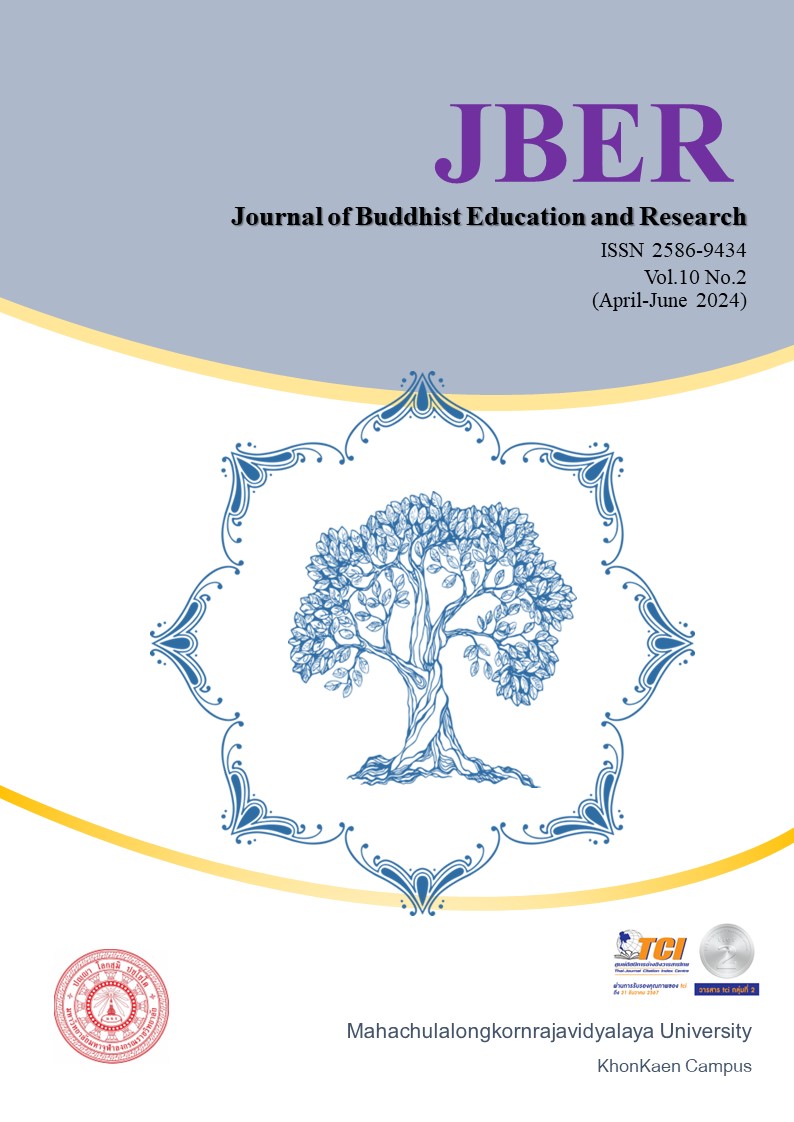THE STRATEGIES FOR THE DEVELOPMENT OF CREATIVE LEARNING MANAGEMENT INNOVATION IN THE ERA OF DISRUPTION IN KHON KAEN SCHOOLS
Keywords:
The strategies for the development of innovation, Creative learning management, the era of disruption.Abstract
The objectives of this research were: 1) to study the current condition, feasibility, and desirable condition of the development of creative learning management innovation; 2) to analyze the strengths, weaknesses, opportunities, and obstacles of the development of creative learning management innovations; 3) to develop and evaluate strategies for developing the creative learning management innovation in the era of disruption in Khon Kaen schools. It is Research & Development R&D by 4 phases. The sample group consisted of 341 Administrators School and teachers. The key informants included 9 school administrators, experts, and stakeholders. The tools were a questionnaire a group discussions and a strategic assessment form. The statistics used in the research were: Percentage value Mean and Standard Deviation, SWOT Matrix Analysis, and PNI modified
The research results were as follows:
1. The current condition of development of innovative creative learning management was statistically rated at a moderate level, while the feasibility and desirable condition were rated at a high level.
2. SWOT Matrix Analysis, The strengths included strategic planning, organizing innovation, and fostering a creative culture. Weaknesses included measuring organizational capabilities, opportunities, public education policies, and technological advancement. The economic and social conditions were obstacles.
3. The strategies for developing the creative learning management innovation in the era of disruption in Khon Kaen schools consisted of (1) to enhance strengths and opportunities along with preventing threats in strategic planning to create the creative learning management innovation; (2) to enhance strengths and opportunities along with preventing threats in organizing the process of creating the creative learning management innovation; (3) to enhance strengths and opportunities along with reducing weaknesses in creating a creative culture; (4) to enhance opportunities along with reducing weaknesses and preventing threats in measuring the organization's ability to create the creative learning management innovation; (5) to enhance strengths and opportunities while minimizing weaknesses and preventing threats in rewarding learning management innovators.
4. Assessment results of creative learning management innovation development strategies In the Disruption era, it is divided into 4 sets with 12 main strategies and 40 secondary strategies. Overall, The main strategy is appropriate and feasible by 93.33 percent The secondary strategy was appropriate and feasible by 92.11 percent and how to proceed is appropriate and feasible 90.35 percent.
References
กระทรวงศึกษาธิการ. พระราชบัญญัติการศึกษาแห่งชาติ พ.ศ.2542 และที่แก้ไขเพิ่มเติม (ฉบับ ที่ 2) พ.ศ. 2545 พร้อมกฎกระทรวงที่เกี่ยวข้องและพระราชบัญญัติการศึกษาภาคบังคับ พ.ศ.2545.กรุงเทพมหานคร: โรงพิมพ์องค์การรับส่งสินค้าและพัสดุภัณฑ์(ร.ส.พ.), 2546.
กาญจนา เดชสม และคณะ. กลยุทธ์การพัฒนากลยุทธ์การพัฒนาความเป็นพลเมืองดิจิทัลของ โรงเรียน มัธยมศึกษา. วารสารมนุษยศาสตร์และสังคมศาสตร์ มหาวิทยาลัยนครพนมปีที่ 13 ฉบับที่ 1(2023).
ธัญนันท์ ปัญเศษ. กลยุทธ์การเสริมสร้างสมรรถนะของผู้เรียนโรงเรียนสองภาษา สังกัดกรุงเทพมหานครสู่ความเป็นเลิศ, วารสารการเมืองการบริหาร และกฎหมาย ปีที่ 13 ฉบับที่ 19 December 2019.
นนทวัฒน์ ตรีนันทวัน และ ปิยะนาถ บุญมีพิพิธ. กลยุทธ์การพัฒนาครูเพื่อการสอนแบบบูรณาการการพัฒนาผู้เรียนอย่างรอบด้านโรงเรียนโสตศึกษาเทพรัตน์ สานักบริหารงานการศึกษาพิเศษ. วารสารฉบับ ภาษาไทย สาขามนุษยศาสตร์สังคมศาสตร์ และศิลปะ ปีที่ 9 ฉบับที่ 3 เดือนกันยายน – ธันวาคม 2559.
พัชรินทร์ ชัยจันทร์ และคณะ. กลยุทธ์การจัดการศึกษาในศตวรรษที่ 21 โรงเรียนสังกัดองค์กรปกครองส่วนท้องถิ่น. วารสารมหาจุฬานาครทรรศน์ ปีที่ 6 ฉบับที่ 8 (ตุลาคม 2562).
วชิราภรณ์ พัดเกิด และคณะ. การพัฒนากลยุทธ์การบริหารและการจัดการหลักสูตรคณะบริหารธุรกิจสถาบันรัชต์ภาคย์. วารสารรัชต์ภาคย์ ปีที่ 14 ฉบับที่ 33 มีนาคม - เมษายน 2563 -TCI กลุ่มที่2 มนุษยศาสตร์และสังคมศาสตร์ ปี 2563-2567.
วรางคณา ผลประเสริฐ, แนวคิดการจัดการเชิงกลยุทธ์. นนทบุรี: หาวิทยาลัยสุโขทัยธรรมาธิราช. 2554.
สมควร นามสีฐาน และคณะ. กลยุทธ์การสอนสังคมศึกษาสู่การพัฒนานวัตกรรมการจัดการเรียนรู้ตามแบบ พุทธวิธี. วารสารวิชาการบัณฑิตศึกษามหาจุฬาขอนแก่น,(TCI 1). ปีที่ 6 ฉบับที่2 (เดือน เมษายน – มิถุนายน 2562)
วิชัย วงษ์ใหญ่ และ มารุต พัฒนผล, การจัดการเรียนรู้ในยุค Disruptive Innovation,กรุงเทพมหานคร: ศูนย์ผู้นำนวัตกรรมหลักสูตรและการเรียนรู้, 2562.
วิพรพรรณ ศรีสุธรรม. การพัฒนาการจัดการเรียนรู้แบบสร้างสรรค์เป็นฐาน เพื่อส่งเสริมการ แก้ปัญหาอย่าง สร้างสรรค์และผลสัมฤทธิ์ทางการเรียนของนักเรียนมัธยมศึกษาปีที่ 4. ปริญญาครุศาสตรมหาบัณฑิต (วิทยาศาสตรศึกษา) มหาวิทยาลัยราชภัฏมหาสารคาม. 2561.
สุทิน แก้วพนา และคณะ. กลยุทธ์การพัฒนาคุณภาพการศึกษาโรงเรียนขนาดเล็ก สานักงานเขตพื้นที่การศึกษาในกลุ่มจังหวัดภาคเหนือตอนบน. วารสารวิจัยราชภัฏเชียงใหม่ ปีที่ 22 ฉบับที่ 1 มกราคม – เมษายน 2564.




